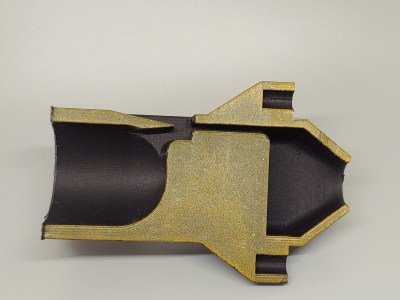We pride ourselves on knowing the proper terms for everyday things: aglet, glabella, borborygmi, ampersands. But we have to confess to never having heard of a “fipple” before finding this interesting MIDI-controlled slide whistle, where we learned that the mouthpiece of a penny whistle or a recorder is known as a fipple. The more you know.
 This lesson comes to us by way of a Twitter post by [The Mixed SIgnal], which showed off the finished mechanism in a short video and not much else. We couldn’t leave that alone, so we reached out for more information and were happy to find that [The Mixed SIgnal] quickly posted a build log on Hackaday.io as well as the build video below.
This lesson comes to us by way of a Twitter post by [The Mixed SIgnal], which showed off the finished mechanism in a short video and not much else. We couldn’t leave that alone, so we reached out for more information and were happy to find that [The Mixed SIgnal] quickly posted a build log on Hackaday.io as well as the build video below.
The slide whistle is a homebrew version of the kind we’ve all probably annoyed our parents with at one time or another, with a 3D-printed fipple (!) and piston, both of which go into a PVC tube. Air is supplied to the pipe with a small centrifugal blower, while a 3D-printed rack and pinion gear of unusual proportions moves the piston back and forth. An Arduino Due with a CNC shield controls the single stepper motor. The crude glissandos of this primitive wind instrument honestly are a little on the quiet side, especially given the racket the stepper and rack and pinion make when queuing up a new note. Perhaps it needs more fipple.
While the humble author is new to fipple-isms, luckily the Hackaday editors see all and know that there two epic hacks featuring fipples to create bottle organs. These are far from the first weirdest instruments we’ve seen — a modulin, a Wubatron, and the Drum-Typeulator all fit that bill well. But we like what [The Mixed Signal] has done here, and we’re looking forward to more.
















Octothorpe, quadthorpe, bithorpe
I remember reading a project log that also complained their midi musician mechanism thing was too loud. They solved it by using pneumatic tubing to actuate the parts near the microphone, then those tubes can go into a soundproof cabinet, or another room for the compressor and noisy bits.
Needs a TMC SilentStepStick.
Fipple is too small in width of mouth. It should approach the diameter of the tube. By fitting a small flat into a round shape there is not enough of the flat area for the wind blade to be loud enough. That is the reason for weak tone as well as the squirrel cage fan. Fans don’t have enough wind pressure. The wind way to the air blade exit point needs to be wide in cross section till the final slot, not a long thin wind way which makes for more resistance to airflow.
This small size makes for a realistic Native American Flute sound though, the sound of which is personal not for performance.
Next should be a valve to apply Midi note on-off commands to. You will need a regulated wind supply as the pressure will rise and fall as notes are keyed.
“While the humble author is new to fipple-isms, luckily the Hackaday editors see all and know that there ARE two epic hacks featuring fipples to create bottle organs.”
Hackaday.com – where “professional” writers are incapable of proofreading
I’m still not seeing the issue
I needed to see this video, everything feels better now.